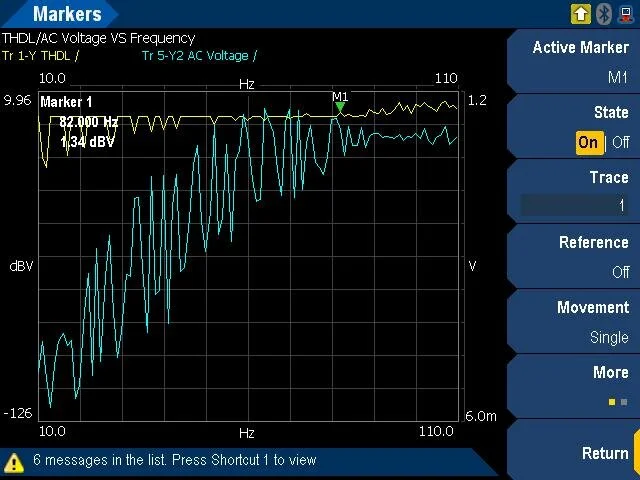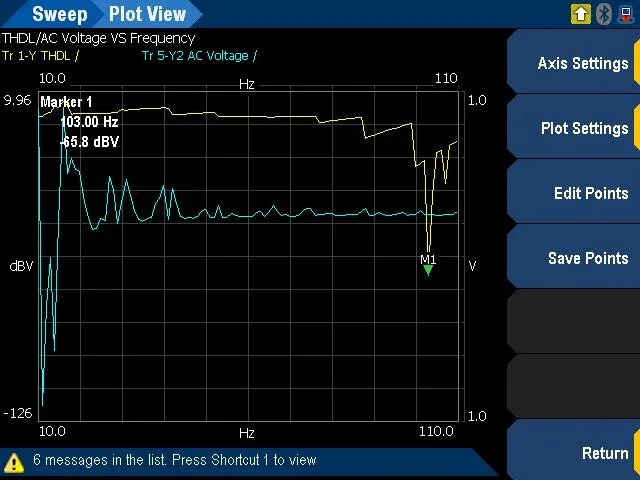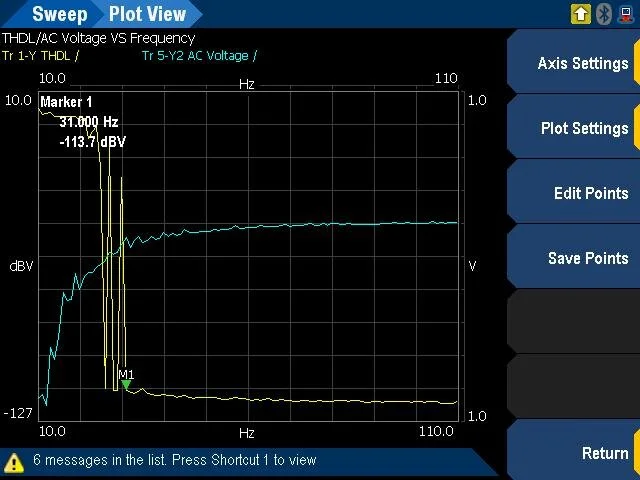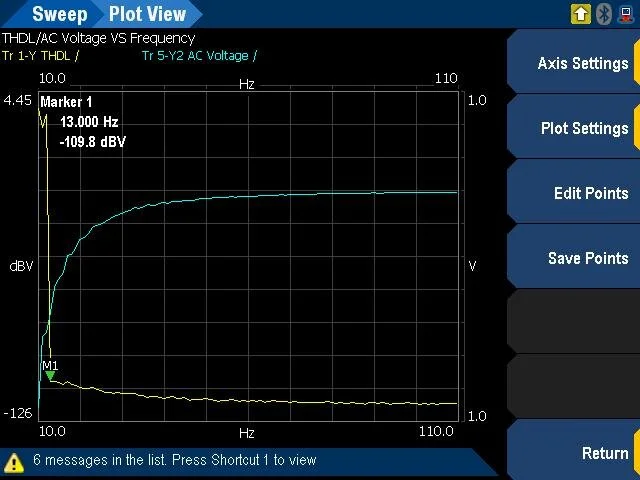KEYSIGHT U8903B AUDIO ANALYZER
SWEPT HARMONIC-DISTORTION INVESTIGATION
BENCHNOTES BN2020-2
Area Focus
Buildera BENCHNOTES™ BN2020-2 documents the Keysight U8903B audio analyzer harmonic distortion at low frequencies between 10 Hz and 110 Hz, and the influence of FFT sample size on distortion-measurement accuracy.
Default THDL measurement (yellow trace) shows erratic results between 10 Hz and 31 Hz. Distortion fluctuates between -113.7 dBV and greater than +0 dbV. FFT sample size: 32768. Frequency step size: 1 Hz.
Background of Investigation
As part of a vibration-analysis investigation using piezoelectric and MEMS sensors, Buildera conducted a series of low-frequency harmonic-distortion measurements below 110 Hz and observed unexpected results at very low frequencies. Namely, the swept harmonic distortion level between 10 Hz to 30 Hz was far higher than published specifications, initially stirring speculation that the generator or analyzer required repair. Buildera took multiple measurements to compare and understand the measurement behavior, which was later presumed to be artifacts of the default FFT resolution setting (32768 samples). Failure to understand this relationship could result in materially erroneous measurements with errors in excess of 100 dBV, particularly at frequencies below 100 Hz.
Test Setup
The test set up included the following equipment:
Device Under Test (“DUT”)
KEYSIGHT® U8903B Audio Analyzer
Supporting Test and Measurement Equipment
None required
Instrument Set Up
To establish an initial reference measurements, BUILDERA set the U8903B as follows:
Analog Analyzer Settings
PARAMETER: Frequency
START FREQUENCY: 10 Hz
STOP FREQUENCY: 110 Hz
POINTS: 101
SPACING: 1.000 Hz
DWELL: 10.00 ms
SRC CHANNELS: 1
MEAS CHANNELS: 1
AG1
AMPLITUDE: 1.0 V(rms)
FREQUENCY: 1 kHz
WAVEFORM: Sine
DC Offset: 0.0000 V
CONN: Loopback
IMP: 50 Ω
GROUND: Float
AA1
TRACE 1: THDL (dBV)
TRACE 2: AC Voltage 0.0000 V
LPF, HPF, W, DeEM: None
CONN: Loopback
DC Offset: 0.0000 V
CONN: Loopback
IMP: 200 kΩ
COUP: AC
BW: 96 kHz
Measurement Results
2048 FFT Samples
4096 FFT Samples
8192 FFT Samples, THDL @ 82 Hz = +3.324 dBV
16384 FFT Samples. THDL @ 103 Hz = -65.8 dBV
32768 FFT Samples (Default setting). THDL @ 56 Hz = -116.8 dBV
65536 FFT Samples. THDL @ 31 Hz =-113.7 dBV
131072 FFT Samples. THDL @13 Hz = -109.8 dBV
262164 FFT Samples. THDL @ 10 Hz = -107.6 dBV
524288 FFT Samples. THDL @ 10 Hz = -107.4 dBV
1048576 FFT Samples. THDL @ 10 Hz = -107.3 dBV. Measurements at 2M samples showed no difference at 10Hz or above.
DUT MEASUREMENTS
To avoid contaminating measurements with external DUT uncertainty, the loopback capability provides a direct internal connection between the output signal (AG1) and the audio analyzer input channel (AA1).
What Do The Measurements Show?
With the Kaiser window enabled, the measurements show that at least 262164 samples are required to reliably measure THDL at frequencies as low as 10 Hz. However, one tradeoff is that increasing the number of samples exponentially extends the measurement time in tandem. This may be acceptable for some R&D situations where measurement speed is less critical, but not for production where fast measurements are critical to throughput. The maximum limit is 2M (2097152) samples, or 2^21. Note that the instrument is capable of generating and analyzing frequencies as low as 5 Hz. Buildera selected a measurement range between 10 Hz to 110 Hz such that each grid line equals an even 10 Hz increment.
At the default setting of 32768 samples, the lowest reliable frequency for total harmonic-level measurement is approximately 70 Hz, below which the THDL fluctuates excessively, requiring a larger FFT sampling window.
The oscillation of THDL is unexplained in the transition region, but is likely due to anomalies from spectral leakage and the particular frequencies chosen. It appears that the FFT analyzer is not coherent with the generated frequencies, causing partial time-domain clipping of an integral number of waveform cycles inside the sampling window.
References
Keysight Technologies. Keysight | U8903B Analog Audio Analyzer - Demo Guide (5992-0667EN). 01 DEC 2017. Online: https://www.keysight.com/us/en/assets/7018-04782/configuration-guides/5992-0667.pdf
Chioye, Luis. Choose the Right FFT Window Function When Evaluating Precision ADCs. Electronic Design. 12-NOV-2013. Online: https://www.electronicdesign.com/technologies/analog/article/21798689/choose-the-right-fft-window-function-when-evaluating-precision-adcs
About BENCHNOTES
BENCHNOTES provide useful insights and tips discovered in the daily engineering and investigation process at BUILDERA. By sharing these findings online or in downloadable PDF format, engineers and consumers benefit from the exploration. BENCHNOTES are informal reports, often with raw, unaudited data.











